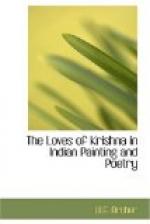The second type is obviously the product of far more sophisticated influences. It is once again a copy of the Gita Govinda and was probably executed in about 1590 in or near Jaunpur in Eastern India. As early as 1465, a manuscript of the leading Jain scripture, the Kalpasutra, had been executed at Jaunpur for a wealthy merchant.[71] Its style was basically Western Indian, yet being executed in an area so far to the east, it also possessed certain novelties of manner. The heads were more squarely shaped, the eyes larger in proportion to the face, the ladies’ drapery fanning out in great angular swirls. The bodies’ contours were also delineated with exquisitely sharp precision. The court at the time was that of Hussain Shah, a member of the marauding Muslim dynasties which since the twelfth century had enveloped Northern India; and it is possibly due to persistent Muslim influence that painting revived in the last two decades of the sixteenth century. Illustrated versions of passionate love poetry were executed[72] and as part of the same vogue for poetic romance, the Gita Govinda may once again have been illustrated.[73] Between the style of these later pictures and that of the Jain text of 1465, there are such clear affinities that the same local tradition is obviously responsible. Yet the new group of paintings has a distinctive elegance all its own. As in the previous group, the detached projecting eye has gone. Each situation is treated with a slashing boldness. There is no longer a sense of cramping detail and the flat red backgrounds of Western Indian painting infuse the settings with hot passion. But it is the treatment of the feminine form which charges the pictures with sophisticated charm. The large breasts, the sweeping dip in the back, the proud curve of the haunches, the agitated jutting-out of the skirts, all these convey an air of vivid sensual charm. That Radha and Krishna should be portrayed in so civilized a manner is evidence of the power which the Krishna story had come to exercise on courtly minds. Krishna is portrayed not as God but as the most elegant of lovers, Radha and the cowgirls as the very embodiment of fashionable women.




